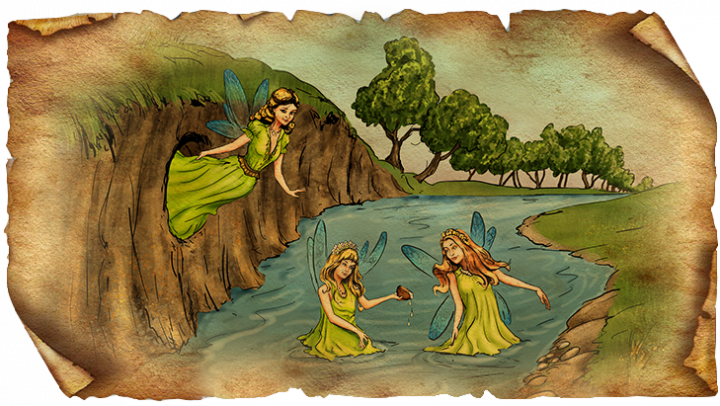Fairy's Hole and the Friars Forest

Nagyernye lies is located on the left bank of the Maros / Mureş River, just ten kilometers from Târgu-Mureş, in the direction of Szászrégen / Reghin. There are several theories and beliefs about the origin of the small village. Some say that it can come from the word small stream, watercourse, others believe that the settlement preserved the name of Ernyei family from the Árpád-era.
According to one of the legends, a nimble-minded girl, Ikla, helped to occupy Belgrade's castle, who later became the wife of a governer named György – they got also an estate on which Ikland village was established. But the Ernyei family lived near them, and Borka, the ugly daughter of the old Ernyei, fell in love with György. During his absence, she wrote untrue letters to George and Ikla, trying to instigate the lovers against each other. According to the saying, the returning György saw Ikla and the priest praying at the edge of the rock, and knowing from the letters that they had a relationship, he pushed both of them into the depths. Borka later regretted her actions, confessed the truth and committed suicide. György built a monastery on the edge of the ravine, then went on a pilgrimage trip. The place next to Nagyernye, where the monastery was probably built, is still called the Friars Forest.
The myth of the snake-killing Bethlens appears also in Ernye. According to this, there was a cave on the clay-bearing bank of Maros between Nagyernye and Várhegy, which was called the Fairy Hole by the locals. It was inhabited by fairies and other fabulous creatures who went to Maros to bath at night. However, there was a giant snake in the cavity, which often carried away the passing oxen and horses. No one could destroy it until the young Count of Bethlen decided to try his luck. He climbed into the Fairy Hole, fixing his blades to his armor and helmet, and when the snake enwound him more and more, the blades cut it so the count did not have to use his weapons to win. The family is therefore called (also) the snake-killing Bethlens.
István Ernyei, originating from the settlement, is mentioned in the early 1300s as the country's palatine by historical sources. The village was one of the symbols of freedom of religion in Transylvania in the late Middle Ages and in the last centuries, as it had five churches at the same time - although the Sabbatarians later migrated to Bözöd / Bezid. Mihály Apafi was appointed as the Prince of Transylvania in 1661, at the camp of Libáncsmező next to Nagyernye.
In the village there were once several noble mansions. The most famous building still to be seen today is the special castle called Bálintitt, which was built in the 18th century in late Baroque style, but it was rebuilt several times in several styles. From its beautiful castle garden and pond nowadays we can see only a few old trees.
Walking alongside Nagyernye, we can see today the Friar Forest, and we can see the old trees guarding the memory of jealous love. It is worth climbing up to the Fairy Hole in good weather – we will probably never see a snake.
According to one of the legends, a nimble-minded girl, Ikla, helped to occupy Belgrade's castle, who later became the wife of a governer named György – they got also an estate on which Ikland village was established. But the Ernyei family lived near them, and Borka, the ugly daughter of the old Ernyei, fell in love with György. During his absence, she wrote untrue letters to George and Ikla, trying to instigate the lovers against each other. According to the saying, the returning György saw Ikla and the priest praying at the edge of the rock, and knowing from the letters that they had a relationship, he pushed both of them into the depths. Borka later regretted her actions, confessed the truth and committed suicide. György built a monastery on the edge of the ravine, then went on a pilgrimage trip. The place next to Nagyernye, where the monastery was probably built, is still called the Friars Forest.
The myth of the snake-killing Bethlens appears also in Ernye. According to this, there was a cave on the clay-bearing bank of Maros between Nagyernye and Várhegy, which was called the Fairy Hole by the locals. It was inhabited by fairies and other fabulous creatures who went to Maros to bath at night. However, there was a giant snake in the cavity, which often carried away the passing oxen and horses. No one could destroy it until the young Count of Bethlen decided to try his luck. He climbed into the Fairy Hole, fixing his blades to his armor and helmet, and when the snake enwound him more and more, the blades cut it so the count did not have to use his weapons to win. The family is therefore called (also) the snake-killing Bethlens.
István Ernyei, originating from the settlement, is mentioned in the early 1300s as the country's palatine by historical sources. The village was one of the symbols of freedom of religion in Transylvania in the late Middle Ages and in the last centuries, as it had five churches at the same time - although the Sabbatarians later migrated to Bözöd / Bezid. Mihály Apafi was appointed as the Prince of Transylvania in 1661, at the camp of Libáncsmező next to Nagyernye.
In the village there were once several noble mansions. The most famous building still to be seen today is the special castle called Bálintitt, which was built in the 18th century in late Baroque style, but it was rebuilt several times in several styles. From its beautiful castle garden and pond nowadays we can see only a few old trees.
Walking alongside Nagyernye, we can see today the Friar Forest, and we can see the old trees guarding the memory of jealous love. It is worth climbing up to the Fairy Hole in good weather – we will probably never see a snake.
